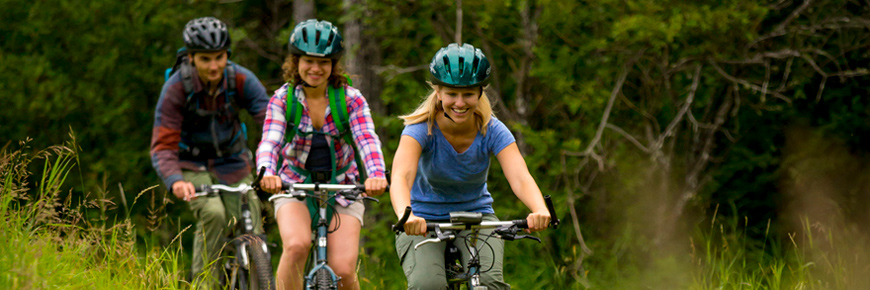
Cycling
Prince Albert National Park
For visitors who enjoy life perched on two wheels, Prince Albert National Park offers a wide range of experiences. Cycling is a wonderful way to explore the park, whether it's a relaxed pedal with family on cycling paths in Waskesiu, a road cycling race among friends down the park’s scenic Highway #263 or an energetic mountain ride up and down the hills of a favourite trail, visitors are sure to enjoy every cycling experience in Prince Albert National Park.
Various types of bicycles are available for rent in Waskesiu. For more information on bike rentals within the park contact the Waskesiu Chamber of Commerce.
Road cycling

Feel the rushing air and the kilometers fly by while cruising the smooth, paved scenic Highway #263 in Prince Albert National Park. Beginning at the intersection of Waskesiu and Lakeview Drive in the town of Waskesiu, the scenic Highway #263 travels 48 km to the park’s south boundary. There are many places to stop and enjoy the view along the way like the Height of Land or Spruce River Highlands lookout towers, or cool off with a swim at Sandy Lake.
Traveling the 15 kilometers of north shore road from Waskesiu to The Hanging Heart Lakes is another fun road cycling adventure. Stop for a rest at one of the beaches along the way or go paddling at the Hanging Heart Lakes.
Please note: Highways within Prince Albert National Park have narrow shoulders. Cyclists should always ride single file and wear a helmet and other personal protective gear including brightly coloured or reflective clothing.
Pedal assist e-bikes
Pedal assist electric bicycles (e-bikes) are allowed on designated bike trails at select national parks.
What does pedal assist mean?
- Power assistance is only provided when the bicycle is being pedalled.
- When pedalling stops, the power assistance also stops.
What other specifications does the bike need?
- The motor can generate a maximum of 500W.
- Power assistance stops when the bicycle attains a speed of 32 km/h on level ground.
Please note that e-bikes equipped with an accelerator (a throttle) are not pedal assist e-bikes and can only be ridden on roads.
Electrical bikes (e-bikes) used on Parks Canada’s trails need to respect the following definition
- has steering handlebars and is equipped with pedals,
- is designed to travel on not more than three wheels in contact with the ground,
- is capable of being propelled by muscular power only,
- has one or more electric motors which have, singly or in combination, the following characteristics:
- it has a total continuous power output rating, measured at the shaft of each motor, of 500 W or less,
- power assistance immediately ceases when the muscular power ceases,
- it is incapable of providing further assistance when the bicycle attains a speed of 32 km/h on level ground,
- is equipped with a safety mechanism that prevents the motor from being engaged before the bicycle attains a speed of 3 km/h.
Mountain biking

Changing forest habitats, rolling hills and breathtaking lookouts make trail riding in Prince Albert National Park a thrill. From easy rides on smooth trails to more technical rides over rocks, roots and hills, the park offers a biking experience that will entertain both novice and advanced riders.
Pack panniers for an unforgettable camping experience. Why not combine a mountain bike adventure with a backcountry camping experience. The Grey Owl and Elk trails both offer great riding and camping facilities.
Check the Visitor Centre for current information on trail conditions, weather forecasts and hazards. If planning on staying overnight in the backcountry, a camping permit is required.
Mountain biking is allowed on all designated trails however the following are recommended;
Recommended trails:
- Spruce River Highlands Trail - 8.5 km
- Elk Trail - 13 km to 15 km (one way)
- Freight Tait Springs Trail - 2 km (one way)
- Hunters Lake Trail - 7.3 km
- Valley View Trail Network - 28.7 km
- Grey Owl Trail - 19.3 km (one way)
- Red Deer Trail Network - 19 km
- Fisher Trail - 6.3 km
To reduce the impact on wildlife, the environment and other visitors, follow proper trail etiquette.
Trail cycling code of ethics
- Stay on the trail. Riding around mud holes damages trailside vegetation.
- Treat other trail users with courtesy, especially on downhill stretches. Slow down when approaching blind spots.
- Use a bell or call out to alert other users and wildlife.
- Choose a trail that matches each rider’s abilities. Park staff or staff at bike shops can help suggest a suitable trail.
- Use bear bells on bikes and make noise when biking through shrubby areas or approaching corners. Review bear safety information before your trip.
- During wildlife encounters on the trail, stop and wait for the animals to move away.
- Dogs must be kept on a leash at all times. This is often awkward and uncomfortable for both the rider and animal. Consider leaving pets at home or with friends.
- Horses have the right of way. In encounters with horse parties, dismount and stand a few feet off the trail (preferably on the downhill side) until the party has passed. When approaching from behind, stay a few metres back to avoid being kicked. Let horse riders know someone is nearby and wait for their instructions before passing.
- Bicycles can take you further into the backcountry than you can walk in a day. You are responsible for your own safety and be prepared to make your own repairs.
- Don't litter! If you pack it in, please pack it out.
Contact the Visitor Centre staff for up-to-date reports or to learn more about visitor safety.
- Date modified :